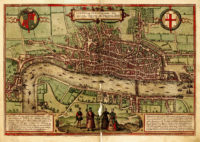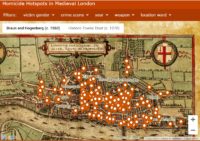Coroners’ inquests in Britain have made frequent appearances on this here blog, but only in their role in determining whether archaeological material is official treasure according to the criteria of the Treasure Act. Commenters have occasionally remarked on how incongruous it is that coroners are tasked with investigating ancient hoards and medieval brooches and Bronze Age hand axes as well as suspicious deaths. Thanks to the efforts of the University of Cambridge, Institute of Criminology, Violence Research Centre, we can now give the profession’s original purpose all due attention.
 UC researchers have created an interactive online map of 142 murders that took place in London in the first half of the 14th century. The London Medieval Murder Map documents the location of the crimes, the years they took place, the means of murder, the identity of the victims and, if known, the killer. You can hover over each pin on the map to get a preview of the information about the homicide that occurred there; click on them to read the whole story. Filters on the top right allow you to group the crimes by categories — victim gender, weapon used, whether the location was public or private, the ward the crime scene was in — and you can explore the vicious underbelly of London on two different maps. One is an Elizabethan-era map, so drawn two centuries after the murders, but it offers a birds-eye view of a London before the explosion of urban development made it diverge radically from the city in the 14th century. The other was created in 1270. To switch between the two, click on the icons in the upper left half of the map.
UC researchers have created an interactive online map of 142 murders that took place in London in the first half of the 14th century. The London Medieval Murder Map documents the location of the crimes, the years they took place, the means of murder, the identity of the victims and, if known, the killer. You can hover over each pin on the map to get a preview of the information about the homicide that occurred there; click on them to read the whole story. Filters on the top right allow you to group the crimes by categories — victim gender, weapon used, whether the location was public or private, the ward the crime scene was in — and you can explore the vicious underbelly of London on two different maps. One is an Elizabethan-era map, so drawn two centuries after the murders, but it offers a birds-eye view of a London before the explosion of urban development made it diverge radically from the city in the 14th century. The other was created in 1270. To switch between the two, click on the icons in the upper left half of the map.
This extraordinary record of crime in medieval London comes down to us in its entirety from Coroner’s inquests. After a sudden death, suicide, accident, murder, any death that was not clearly attributable to natural causes, the coroner and sheriff would assemble a jury to investigate the circumstances. Coroners had jurisdiction over the 24 wards — neighborhoods inside and outside the old Roman wall that were largely self-governing — of London. Juries were composed of free men from the ward in which the body had been found and from three adjacent wards. Juries could have as few as 12 members or as many as 50.
 The conclusions drawn by the officials and jury at the inquest were documented in the Coroners’ Rolls. In the case of homicides, they included a summary of the location and time of the murder, the parties involved, the weapon used and the types of the wounds. The rolls also included the jury’s answers to questions about witnesses, the fate of the murders and items found at the scene of the crime.
The conclusions drawn by the officials and jury at the inquest were documented in the Coroners’ Rolls. In the case of homicides, they included a summary of the location and time of the murder, the parties involved, the weapon used and the types of the wounds. The rolls also included the jury’s answers to questions about witnesses, the fate of the murders and items found at the scene of the crime.
There are nine extant Coroners’ Rolls from London between 1300 and 1340. The years from 1301 through 1314 and 1317 through 1320 have been lost. The 142 homicides pinned on the map are the murders documented in the surviving Coroners’ Rolls.
It’s a fascinating browse. The information encompasses not just the Clue-like summations (“Male in public with a long knife”), but also interesting names, vernacular that can delicately be described as colorful and an overall picture of life and death in the big city that is sometimes rendered in minute detail. There are also statistical data that can be compiled from the rolls, like for instance that by far the most murders, 52.8% of them, took place in public squares and streets. That’s 75 murders. Only six happened in a tavern, the same number that happened in a religious building. Brothels and prisons were comparatively safe places with only two and one murder recorded respectively. The weapon of choice was the long knife, with 51 bodies on its blade. The short knife takes second place with 29, and the bronze goes to the staff. Ten more people were killed with staffs than with swords.
This coincides with the launch of the ‘Layers of London’ website:
https://www.layersoflondon.org
“Layers of London brings together, for the first time, a significant collection of digitised historic maps, photos and other information provided by key partners across London. Our partners include: the British Library, The London Metropolitan Archives, Historic England, The National Archives, MOLA (Museum of London Archaeology) and a wide range of national and local archives, institutions and community groups.”
And they say folks are history illiterate! Philadelphia has a version: “I had no idea that a Vampires, Sex, & Ghosts :skull: tour would be so full of great history and fun facts. It makes it extremely entertaining to learn about the city in a whole new perspective. Our tour guide Joe made the experience even better because his personality is very genuine which makes the tour feel more personal ,thrilling, humorous, outstanding, original, and raw. It was so informative and funny, beyond all expectations and I can’t wait to take the Serial Killer one and tell the rest of my friends about it.” 🙂
My wife can remember a Shakespeare critic saying that Romeo and Juliet wasn’t about Young Lurve, it was about gangs and knife crime in London.
And down the rabbit hole I go…. :hattip: